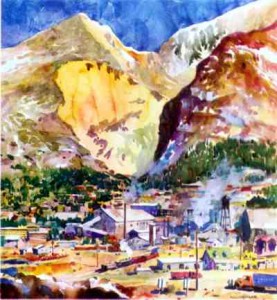Brief by Central Staff
Geography – June 2006 – Colorado Central Magazine
We sometimes explain Colorado Central as “the monthly magazine for America’s highest deserts,” but a recent excursion got us to wondering about high deserts. That’s because we visited the Museum of the High Desert just outside Bend, Ore. There, the “high desert” is defined as a combination of the Columbia Plateau and the Great Basin, and does not extend to Colorado.
Anyone who’s driven from, say, Salt Lake City, Utah, to Burns, Ore., will agree that the intervening landscape is a desert. And it’s high by global standards, if not ours. The average elevation of the Great Basin is about 3,300 feet, and the Columbia Plateau runs 4,000 to 6,000 feet above the tides.
California also claims a “high desert” in the Barstow area, which is about 2,200 feet above sea level and gets 4.4 inches of rain in an average year.
Our neighbors in New Mexico are celebrating “Fifty years of High Desert Song” at the Santa Fé Opera. At 6,995 feet, Santa Fé is the highest state capital in the United States (next is Cheyenne, Wyo., at 6,089, followed by mile-high Denver), and Santa Fé’s average annual precipitation is 13.84 inches.
[InContentAdTwo]
That’s not much water (20 inches is about what it takes to grow normal crops without irrigation), so it’s certainly arid. The line between dry and desert is not clearly defined, but the authorities we consulted put it at 10 to 12 inches of annual precipitation.
Thus most of our high part of the world is desert or very close to it: Salida, 7,033 feet and 10.13 inches; Buena Vista, 7,940, 10.24; Gunnison, 7,703, 10.44; Antero Reservoir (South Park), 8,973, 10.10; Saguache, 7,707, 8.33; Alamosa, 7,543, 7.09.
Even our wettest places, ones that get more than a foot of annual precipitation, aren’t all that wet. Westcliffe, 7,867, gets 14.44 inches, and Leadville, America’s highest city at 10,161, receives 15.69 inches a year.
Thus we can reasonably claim to be in “America’s highest desert” even though there are several high deserts in our country. The world’s highest desert is the Tibetan Plateau, where annual precipitation runs 4-12 inches, and the average elevation is 14,100 feet, about the top of Pike’s Peak.
And in the course of our research to validate our claim about serving America’s highest deserts, we discovered that 2006 has been declared the International Year of Deserts and Desertification.


